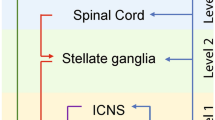We studied the role of both parts of the autonomic intracardiac nervous system in the pathogenesis of atrial fibrillation (AF). In 12 pigs weighing 39±3 kg, AF was induced by burst stimulation. Chemical inactivation of intrinsic cardiac neurons within the right atria was performed by transendocardial injections of liposomal neuromodulators into the dorsal part of the right atrial wall. Sympathetic and parasympathetic terminals were inactivated with 6-hydroxydopamine (6-OHDA, n=6) and ethylcholine aziridinium ion (AF64A, n=6), respectively. Neuromodulators were encapsulated in liposomes (LS) with diameters of 310±50 nm for OHDA and 290±50 nm for AF64A. LS-6-OHDA and LS-AF64A were injected into the ganglionated plexuses after measuring the baseline effective refractory period and assessing myocardial resistance to AF. These measurements were repeated 90 min after the injections. The optimal doses were 0.2 mg/kg for LS-6-OHDA and 0.4 mg/kg for LS-AF64A (in 4 ml of suspension). Immediately after injections of liposomal neuromodulators, almost all pigs showed an increase in HR, and a short-term BP elevation was observed in the LS-AF64A group. At the end of the experiment, similar decrease in the effective refractory period and similar increase in the resistance to AF were observed in all animals. Thus, selective chemical inactivation of cholinergic and adrenergic terminals of the intracardiac nervous system with liposomal neuromodulators increased the resistance to AF in an acute experiment. However, the short observation period does not allow making a definite conclusion about the role of the autonomic nervous system in the pathogenesis of AF, which requires verification of the obtained data in a chronic experiment.
Similar content being viewed by others
References
Hanna P, Dacey MJ, Brennan J, Moss A, Robbins S, Achanta S, Biscola NP, Swid MA, Rajendran PS, Mori S, Hadaya JE, Smith EH, Peirce SG, Chen J, Havton LA, Cheng ZJ, Vadigepalli R, Schwaber J, Lux RL, Efimov I, Tompkins JD, Hoover DB, Ardell JL, Shivkumar K. Innervation and neuronal control of the mammalian sinoatrial node a comprehensive atlas. Circ. Res. 2021;128(9):1279-1296. https://doi.org/10.1161/CIRCRESAHA.120.318458
Wake E, Brack K. Characterization of the intrinsic cardiac nervous system. Auton. Neurosci. 2016;199:3-16. https://doi.org/10.1016/j.autneu.2016.08.006
Jungen C, Scherschel K, Eickholt C, Kuklik P, Klatt N, Bork N, Salzbrunn T, Alken F, Angendohr S, Klene C, Mester J, Klöcker N, Veldkamp MW, Schumacher U, Willems S, Nikolaev VO, Meyer C. Disruption of cardiac cholinergic neurons enhances susceptibility to ventricular arrhythmias. Nat. Commun. 2017;8:14155. https://doi.org/10.1038/ncomms14155
Male S, Scherlag BJ. Role of neural modulation in the pathophysiology of atrial fibrillation. Indian J. Med. Res. 2014;139(4):512-522.
Friberg L, Hammar N, Rosenqvist M. Stroke in paroxysmal atrial fibrillation: report from the Stockholm Cohort of Atrial Fibrillation. Eur. Heart J. 2010;31(8):967-975. https://doi.org/10.1093/eurheartj/ehn599
Carnagarin R, Kiuchi MG, Ho JK, Matthews VB, Schlaich MP. Sympathetic nervous system activation and its modulation: role in atrial fibrillation. Front. Neurosci. 2019;12:1058. https://doi.org/10.3389/fnins.2018.01058
Sharifov OF, Fedorov VV, Beloshapko GG, Glukhov AV, Yushmanova AV, Rosenshtraukh LV. Roles of adrenergic and cholinergic stimulation in spontaneous atrial fibrillation in dogs. J. Am. Coll. Cardiol. 2004;43(3):483-490. https://doi.org/10.1016/j.jacc.2003.09.030
Jiang YH, Jiang P, Yang JL, Ma DF, Lin HQ, Su WG, Wang Z, Li X. Cardiac dysregulation and myocardial injury in a 6-hydroxydopamine-induced rat model of sympathetic denervation. PLoS One. 2015;10(7):e0133971. https://doi.org/10.1371/journal.pone.0133971
Varešlija D, Tipton KF, Davey GP, McDonald AG. 6-Hydroxydopamine: a far from simple neurotoxin. J. Neural Transm. (Vienna). 2020;127(2):213-230. https://doi.org/10.1007/s00702-019-02133-6
Farzam A, Chohan K, Strmiskova M, Hewitt SJ, Park DS, Pezacki JP, Özcelik D. A functionalized hydroxydopamine quinone links thiol modification to neuronal cell death. Redox Biol. 2020;28:101377. https://doi.org/10.1016/j.redox.2019.101377
Rose M, Dudas B, Cornelli U, Hanin I. Glycosaminoglycan C3 protects against AF64A-induced cholinotoxicity in a dose-dependent and time-dependent manner. Brain Res. 2004;1015(1-2):96-102. https://doi.org/10.1016/j.brainres.2004.04.048
Clauss S, Schüttler D, Bleyer C, Vlcek J, Shakarami M, Tomsits P, Schneider S, Maderspacher F, Chataut K, Trebo A, Wang C, Kleeberger J, Xia R, Baloch E, Hildebrand B, Massberg S, Wakili R, Kääb S. Characterization of a porcine model of atrial arrhythmogenicity in the context of ischaemic heart failure. PLoS One. 2020;15(5):e0232374. https://doi.org/10.1371/journal.pone.0232374
Strel’nikov AG, Yakubov AA, Sergeevichev DS, Artemenko SN, Mikheenko IL, Abashkin SA, Romanov AB, Pokushalov EA. Endocardial botulinum toxin injection into ganglionated plexi in order to reduce atrial fibrillation inducibility. Patol. Krovoobr. Kardiokhir. 2015;19(4):99-107. Russian.
Author information
Authors and Affiliations
Corresponding author
Additional information
Translated from Byulleten’ Eksperimental’noi Biologii i Meditsiny, Vol. 174, No. 8, pp. 136-142, August, 2022
Rights and permissions
Springer Nature or its licensor (e.g. a society or other partner) holds exclusive rights to this article under a publishing agreement with the author(s) or other rightsholder(s); author self-archiving of the accepted manuscript version of this article is solely governed by the terms of such publishing agreement and applicable law.
About this article
Cite this article
Korolev, D.V., Sonin, D.L., Medved, M.S. et al. Acute Effect of Selective Chemical Inactivation of Sympathetic or Parasympathetic Atrial Ganglionated Plexus Structures on Atrial Fibrillation Inducibility in Pigs. Bull Exp Biol Med 174, 179–184 (2022). https://doi.org/10.1007/s10517-023-05669-6
Received:
Published:
Issue Date:
DOI: https://doi.org/10.1007/s10517-023-05669-6




